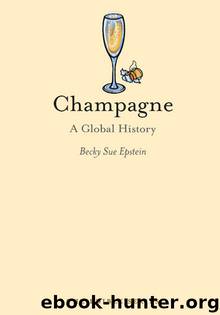Champagne by Becky Sue Epstein

Author:Becky Sue Epstein
Language: eng
Format: epub
Publisher: Reaktion Books
Mme Bollinger on her trademark bicycle in the Champagne countryside, 1960s.
I only drink champagne when I’m happy, or when
I’m sad.
I sometimes drink it when I’m alone.
When I have company, I consider it obligatory.
I trifle with it if I am not hungry and drink it when I am.
Otherwise I never touch it – unless I’m thirsty.
Lily had taken over Bollinger when her husband died in 1941, and after the war was the first to visit Britain and the United States to re-energize her brand – and incidentally, champagne in general. Lily Bollinger was also the first to produce the sparkling wine she labelled RD (for récemment dégorgé), which means that the wine had been kept on the lees longer, and disgorged later, to add complexity and depth to its flavours and aromas. The first Bollinger RD was vintage 1952, released in 1961. This practice has been followed by other producers; the champagnes are now called ‘late disgorged’.
Though champagne had occasional struggles in the world-wide economy well into the 1970s, the large champagne houses continued to specialize in blending grapes for their own signature styles of sparkling wines, and they could call the shots on the prices they paid for grapes. The hundreds of village vineyards had been ranked, starting at the top with grand cru, then premier cru, then village vineyards. These quality gradations were mirrored in the prices paid for the grapes. There was a certain amount of resentment among the growers, but they could do very little about it without the resources to make their own champagnes. In Champagne, the champagne houses ruled.
Elsewhere, it was another story. After the mid-twentieth century when the middle class had grown and become more financially secure, a new economic genre arose, the aspirationally affluent. Both of these groups embraced champagne’s luxury positioning. They saw themselves as part of champagne’s targeted upscale market. They wanted to drink more sparkling wine even if they couldn’t always afford champagne. Certain sparkling wine makers took notice of aspirational champagne buyers and they flooded the market with cheap, sweet sparklers like ‘pink champagne’ and Cold Duck. Gradually these products lost out to the increasingly sophisticated taste of the middle and upper middle classes who travelled and learned more about food and wine. During the late twentieth century, producers in many established wine regions around the world began to upgrade their sparkling wine making, and to aim their products at this new group of more savvy customers. In Burgundy, for example, quality had varied for many decades until controls were put in place in 1943, with the creation of a ‘Bourgogne Mousseux’ appellation, which defined the vineyard area and production quality of these wines. In the 1970s, a group of producers instituted further quality controls for their vines, vineyards and wines, and were instrumental in establishing the new sparkling wine appellation (Appellation d’Origine Contrôllée, or AOC), ‘Crémant de Bourgogne’ in 1975.
Download
This site does not store any files on its server. We only index and link to content provided by other sites. Please contact the content providers to delete copyright contents if any and email us, we'll remove relevant links or contents immediately.
Ottolenghi Simple by Yotam Ottolenghi(3519)
BraveTart by Stella Parks(3395)
Trullo by Tim Siadatan(3380)
Bake with Anna Olson by Anna Olson(3357)
Harry Potter and the Prisoner of Azkaban (Book 3) by J. K. Rowling(3304)
Nigella Bites (Nigella Collection) by Nigella Lawson(3173)
Tom Kerridge's Dopamine Diet: My low-carb, stay-happy way to lose weight by Kerridge Tom(3065)
Best of Jane Grigson by Jane Grigson(2947)
Classic by Mary Berry(2943)
Solo Food by Janneke Vreugdenhil(2931)
Sweet by Ottolenghi Yotam & Goh Helen(2888)
Ottolenghi - The Cookbook by Yotam Ottolenghi(2871)
Flavor Flours by Alice Medrich(2815)
Coffee for One by KJ Fallon(2569)
Hot Sauce Nation by Denver Nicks(2451)
Veg by Jamie Oliver(2411)
Claridge's: The Cookbook by Nail Martyn & Erickson Meredith(2359)
Chefs & Company: 75 Top Chefs Share More Than 180 Recipes To Wow Last-Minute Guests by Isabella Maria(2004)
Lose Weight for Good by Tom Kerridge(1889)
